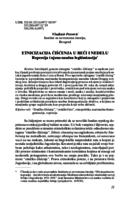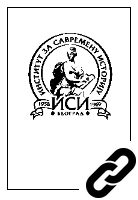2. Naučni članci
-

-
Etnizacija čišćenja u reči i nedelu
-
Istražujući genezu sintagme “etničko čišćenje” u srpskom jeziku,
Članak proširuje postojeća istraživanja koja nastanak pojma smeštaju u kontekst
jugoslovenske krize i rata u Bosni. Prve upotrebe sintagme “etnički čistog”
lociraju se u projektima nacionalne homogenizacije nastalim tokom Drugog svetskog
rata. Interpretiraju se kao ishod dugotrajnog procesa u kojem je termin čišćenje, korišćen u drugoj polovini 19. i prvoj polovini 20. veka da označi uklanjanje
političkih prepreka i protivnika, etniciziran pod uticajem razvoja nauka
o čoveku. Eksplozivna se smesa znanja i moći, nauke i nasilja, karakteristična
za visoku modernu, prati kroz međuratne predloge rešavanja manjinskog pitanja.
Drugi svetski rat se sagledava kao katalizator koji je omogu}io i pojmovnu
i praktičnu artikulaciju projekata nasilne homogenizacije društva, u kojima su
manjinske grupe sagledavane kao prepreka koju treba ukloniti., Published, Članak je deo rada na projektu Instituta za savremenu istoriju “(Ne)uspešna integracija
– (ne)dovršena modernizacija: Međunarodni položaj i unutrašnji razvoj
Srbije i Jugoslavije 1921-1991”, koji finansira Ministarstvo za nauku i zaštitu životne
sredine republike Srbije (projekat br. 147039).
-

-
Power(lessness) of Atrocity Images: Bijeljina Photos between Perpetration and Prosecution of War Crimes in the Former Yugoslavia
-
The wars in the former Yugoslavia coincided with both the rise of international
transitional justice discourses and with a revolution in visual recording, resulting in an
abundance of visuals documenting extreme violence. This article investigates the conditions
behind the creation of such visual material, as well as the impact of its circulation
on the delivery of justice in the former Yugoslavia. The visual record of unpunished
crimes is examined in one of the most infamous wartime photographs, taken in the
Bosnian city of Bijeljina in the spring of 1992. In it, a young, armed man in a military
uniform, sunglasses on his head, cigarette in his hand, attempts to hold his balance
while kicking a dead woman. This photo became one of the quintessential representations
of war in Bosnia. The circumstances of its creation, circulation and contestation
are paradigmatic of the troubled process of coming to terms with the criminal past in
Serbia, with wider ramifications for the use of visuals in other regions affected by mass
violence.
-

-
RASPAD SFRJ: KRIZA, EROZIJA, PAT
-
Članak se bavi prerastanjem jugoslovenske krize koja je
obeležila osamdesete godine u paralizu najavljenu prekidom poslednjeg
kongresa SKJ i pregrupisavanjem političkih snaga tokom 1990. Razlaz
republičkih rukovodstava praćen rascepom Predsedništva SFRJ, te raskorak između Predsedništva, Saveznog izvršnog veća i vojnog vrha, prati se kroz neuspešna nastojanja da se zaustavi erozija bezbednosne situacije u SFRJ krajem 1990. i početkom 1991. Kroz dokumentarni materijal, medijske izvore i sećanja protagonista analiziraju se aktivnost i
uzajamni odnosi ključnih aktera ovih procesa., The article is scrutinizing stages of disintegration of SFRY, from the crisis
which characterized the 80s to erosion heralded with the disintegration of LCY and
realignment of political players during 1990. The collision between leaderships of
republics, which produced divisions within the state Presidency, as well as collision
between the Presidency, Federal Executive Council and the military is traced through the failed attempts to stop the erosion of the security situation in Yugoslavia
at thte end of 1990 and beginning of 1991. Through the documents, media sources
and the memories of participants, the article analyses activity and mutual raltions
of key actors in the period of deepening og Yugoslav crisis in the direction of
paralysis and violent disintegration of the state, Published, 177016, Članak je deo projekta Srpsko društvo u jugoslovenskoj državi u 20. veku – između
demokratije i diktature (177016) koji finansira Ministarstvo prosvete, nauke i tehnološkog
razvoja Republike Srbije.
-

-
Raspad SFRJ
-
Članak se bavi uticajem raspada saveznog nivoa vlasti u SFRJ na prerastanje jugoslovenske krize u oružani sukob. Izdvajaju se glavni akteri i ključne etape ovog procesa tokom prve polovine 1991, obeležene podelama unutar Predsedništva SFRJ, marginalizacijom Savezne skupštine i njenog Izvršnog veća, kao i rastućom autonomijom republičkih rukovodstava i vojnog vrha. Na osnovu memoara protagonista i dostupnog arhivskog materijala prati se blokada u radu saveznih institucija koja je onemogućavala rešavanje problema političkim putem i prerastala u paralizu tokom koje su se umnožavali oružani incidenti. Uzajamno podeljeni, nosioci savezne vlasti su abdicirali pred republičkim rukovodstvima, ili su suprotstavljenim akcijama otvorili put
poslednjoj etapi jugoslovenske agonije., This article scrutinizes the disintegration of the federal level of government of the SFRY and its role in transforming the Yugoslav crisis into an armed conflict. This was a culmination of a long process in which centrifugal tendencies overcame the integrative capacity of Yugoslavia. A deep economic and social crisis surged dramatically in the wake of the collapse of the League of
Communists of Yugoslavia in January 1990. This crisis led to a paralysis of the federal level of government exactly at the time which called for radical transformation and adjustment to the global changes signaled by the fall of the Berlin Wall. The Yugoslav government (Federal Executive Council), led by Ante Marković, was spearheading such a reformist program, but it faced ever stronger opposition from the conservative leadership of the armed forces. The agenda of the military, meanwhile, prioritized the preservation of the system, even at the expense of the country’s modernization. The space for addressing the mounting problems on the federal level was thus narrowing, enabling constitutive republics to act out their conflicting political projects. Empowered additionally by elections, which were never held on the federal level, leaders of the most influential republics fostered irreconcilable visions: Slovenia under Milan Kučan was planning its independence, hence changing Yugoslav external borders. Serbia under Slobodan Milošević was plotting to redraw internal borders between the republics, and Croatia under Franjo Tuđman was aiming to do both. The realization of such disparate plans called for the instrumentalization or marginalization of the federal government. In early 1991, this process was set in motion. The growing autonomy of republican leadership resulted in divisions within the SFRY Presidency and its inability to act decisively during the period in which Serbia undermined the federal monetary system, Croatia imported arms from abroad, and Slovenia held an independence referendum. Unchecked by civilian authorities, armed forces were pushing the Presidency into action through systemic pressures, peaking with an aborted coup in mid-March. The Yugoslav Presidency was hence effectively sidetracked, whereas the political dialogue about the Yugoslav future was relegated to summits of republican leaderships. These summits, held in late March and throughout April, did not produce any tangible results, as their actors
attempted to legitimize their own positions by avoiding responsibility for the impending collapse and angled to maximize their gains in its course. The remaining federal authorities, Yugoslav government, and the military did attempt to stall this process. However, they failed to coordinate, maneuvering instead to oust each other. These attempts were abandoned in early May, amidst a number of armed incidents. With an increasing number of fatalities, the chances for peaceful resolution of the Yugoslav crisis were dwindling. Yugoslav federal authorities were increasingly unable to influence the course of events. Paralysis of the federal institutions blocked any institutional path toward resolving political problems. As the country moved from collapse into war, the divided representatives of the federal government either abdicated in front of their republican leaderships, or acted in cross-purposes, opening the path to the last stage of the
Yugoslav agony., Published, Šifra projekta: 177016, Rad je deo projekta Srpsko društvo u jugoslovenskoj državi u 20. veku – između demokratije i diktature (177 016), koji finansira Ministarstvo prosvete, nauke i tehnološkog razvoja Republike Srbije.
-

-
The ICTY Library
-
The purpose of this contribution is to shed light on the literary output of persons indicted or sentenced for war crimes in the International Criminal Tribunal for the former Yugoslavia (ICTY). Over one hundred books—autobiographies, studies, collections of documents, and even novels and poetry have been generated by no less than 22 persons in the detention unit of the ICTY in The Hague since 1993. Although some of these works did cause an occasional stir, as of yet there is no detailed overview of the entirety of this literary output. In order to fill this gap, this article assembles a full collection of works produced by ICTY inmates and analyzes this genre, the motivations of its authors, and the implications of their work. Examined as sources, these works can be used to study the collapse of the former Yugoslavia, the work of the ICTY, and its perception by the accused. I conclude by examining the corrosive role these works play in the process of coming to terms with the troubled past of the region., Published, Šifra projekta: 177016
-

-
Šta je prevladavanje prošlosti i zašto u Srbiji hramlje
-
Prilog analizira koncept prevladavanja prošlosti, defi niše glavne aspekte i skicira osnovnu dinamiku ovog procesa. Posebno se insistira na važnosti prerastanja zagovaranja suočavanja sa prošlošću, čiji je nosilac građansko društvo, u jasnu politiku tranzicione pravde, čiji je nosilac država. Ova tranzicija se sagledava na primeru Savezne Republike Nemačke, koji karakterišu veliki pomaci u ovoj oblasti, kao i simptomatični propusti. Ističu se specifi čnost sa kojima se u ovoj oblasti suočavaju postjugoslovenska društva, sa posebnim osvrtom na probleme koji u Srbiji sputavaju takav razvoj., This contribution analyses the concept of overcoming the past, defi nes its aspects and main dynamics. The importance of transformation of facing the past advocacy, shaped by the civil society, into the well-defi ned policy of transitional justice, carried out by the state is emphasized. This transition is analyzed on the example of Germany, whose accomplishments as well as setbacks in this area are scrutinized. The example of socialist Yugoslavia is evoked as a contrast, with particular emphasis on problems which are hindering this process in Serbia., Published, Šifra projekta: 47030, Članak je nastao u okviru projekta Konfl ikti i krize: saradnja i razvoj u Srbiji i regionu u 19. i 20. veku, (projekat III 47030) koji finansira Ministarstvo prosvete, nauke i tehnološkog razvoja Vlade Republike Srbije.


